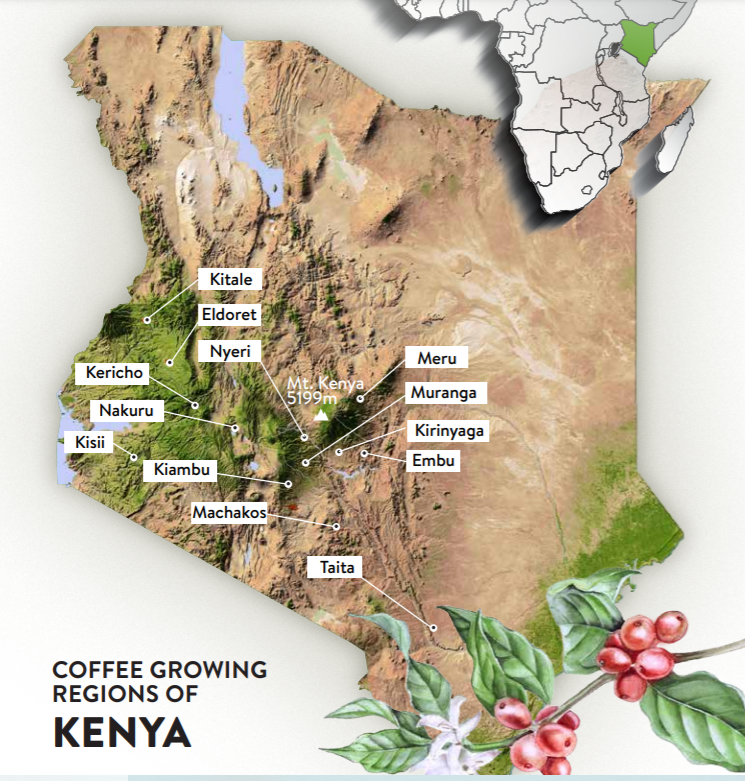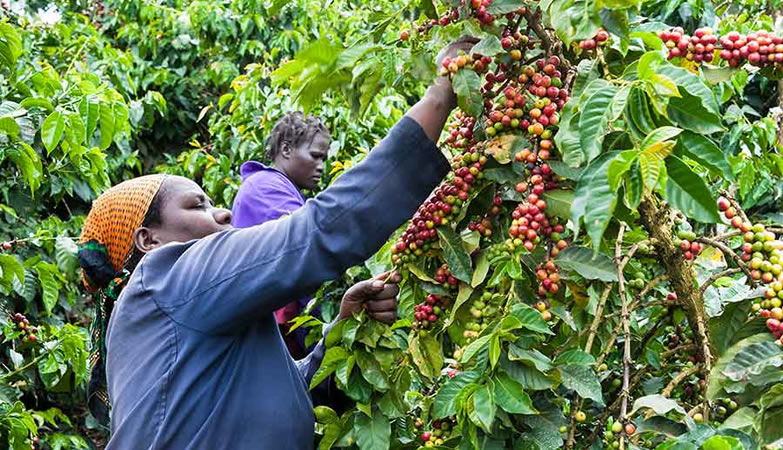
KENYA
KENYA : Taste of originality and difference
After more than 120 years of beginning and development, Kenya has become an indispensable name in the coffee world.
Kenya is officially the Republic of Kenya, a country in East Africa with a square of about 582,647 km2, of which 13,296 km2 is the sea surface. Located next to the cradle of the world coffee - Ethiopia in the North - and the famous Tanzania coffee land in the South, Kenya also has a unique historical flow of coffee culture.
Kenyan coffee - a special history
Although Kenya is next to the cradle of world coffee - Ethiopia, it started growing coffee about 120 years ago which may be a big surprise to many people. Until the mid-19th century, Kenya was nowhere to the West, while trading between this country with others of Africa and Central Asia began a long time ago. Only when German missionaries came here and brought the story of a land with majestic mountains and lakes to Europe, did people start to search, explore and settle in Kenya. Coffee came to Kenya in this period.

In 1893, Scottish missionaries brought coffee seeds from Aden, Yemen, and nursed them in the land of Kibwezi, near the coast of Mombasa. Cultivation and fertilization expanded to Nairobi in 1900, and by 1912 the coffee acreage had increased to hundreds of acres. Kenya was then a British colony in 1920, during this time the British built a system to produce and promote Kenyan coffee. In 1963, Kenya gained independence and improved the facilities for the coffee industry development. As a result, Kenyan coffee is today one of the best in the world.

The unique taste
Kenyan coffee is famous for its rich and full, balanced, and varied flavor. People can find a sweet reminiscent of fruit wine and other tastes in a cup of coffee. Mostly, Kenyan coffee is grown in an average altitude of 1,500 to 2,100 m above sea level, with volcanic soils that are rich in minerals. Coffee trees are planted mainly in Nyeri, Murang’a, Kirinyaga, Embu, and Meru in the northeastern of Nairobi province, near the top of Kenya; or in the eastern provinces of Kisii, Nyanza, Bungoma and Kakamega, and Nakuru, Trans Nzoia, Kericho, Kajiado in the Great Rift valley.
Coffee from Kenya is mainly Arabica, especially the Bourbon SL 28 and SL 34 hybrids. These cultivars were found and developed by a Scottish research department in the 1950s. By the 1990s, the Ruiru 11 with high disease resistance was developed and tested in small areas. Most of Kenyan highest quality coffees are from small households with an area of 0.25 - 3 acres. Later, for commercial purposes, these small farmers built production complexes. The Eastern African Fine Coffee Association (EAFCA) estimates that there are more than 700,000 smallholders, 500 production groups with about 320 large production units, and 3,500 medium production units, with an area of 50 - 100 acres. Generally, these units have their preliminary processing areas. Smallholder farmers account for 58% of the output and 75% of the planted area.
Auction tension
Like coffee from Tanzania, coffee in Kenya is mainly wet-processed, dried naturally, and sent to processing factories for quality classification. Checked and graded coffee can be auctioned at weekly stalls starting in 1935 by the government in Nairobi. In preparation for the auction, exporters send samples to international traders, followed by an auction process. This auction system has received many compliments for its transparency and fairness. However, exporters have encountered some cases of non-payment or delay in payment recently after the auction.
In 2006, the Kenyan government legalized the direct trade law that allowed farmers to sell goods directly to buyers without an auction. This law is also known as the "second window", allowing farmers to access the market and large commercial companies to have more incentives and opportunities. Afterward, they can invest in services and assistance. Even so, about 90-95% of the coffee sold in Kenya is still through auction.

The challenge for Kenyan coffee
In the stage of promoting the development of the coffee industry, Kenya faced many challenges. Firstly, the government had to ensure the long-term profits for farmers who suffered a decreasing output. Accordingly, about 70% of the Kenyan coffee area was directly affected by rainfall. Meanwhile, the cost of fertilizer and labor increased.
The second challenge relates to inheritance. Statistically, the average life expectancy of a coffee farmer is 55 years old only. The current inheritance law requires farmers to divide the land among descendants, which makes the cultivated area smaller and makes it arduous to get secured profits.
Besides, traceability is also a big barrier to the development of Kenyan coffee. Indeed, it is difficult for consumers to know the exact origin of products when more than 90% of farmers choose to sell coffee through the auction. Only the highest quality products labeled "AA" generally receive the most attention.
Not until BD Imports started buying Kenyan coffee in 1999, most buyers were unaware of the domestic producers. “Importers have branded themselves on coffee,” John recalls. In the current market, producers can completely ignore the auction stage and trade directly, making the names of coffee regions or cooperatives more popular with consumers. But in fact, farmers in Kenya still choose the auction as the main method for their purchasing activities..
In the growing market, getting a certification of safety, quality, and reputation is to maintain a foothold for products. Most of the coffee grown on large farms is not shaded, so it is susceptible to diseases leading to agricultural drugs requirement. On the contrary, small farmers do not have enough money to invest in agricultural medicine, so they mix their products with those from big farms. Besides, it is pricey to get the certification, so smallholders do not seem eligible to invest.

Although there are many challenges, there are also many opportunities for Kenyan coffee to expand and develop. At present, Kenyan coffee has a firm foothold and trust from users in the international market. Moreover, new, cherished ideas for the development of the coffee industry are spreading in Kenya.
